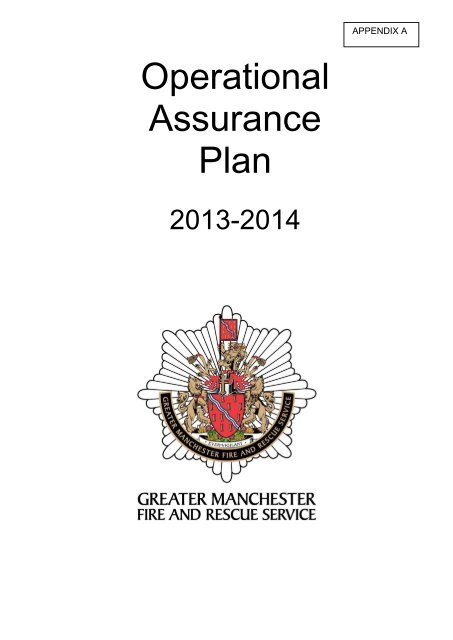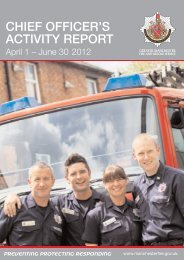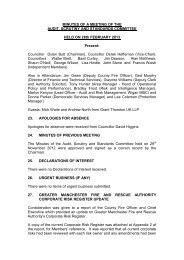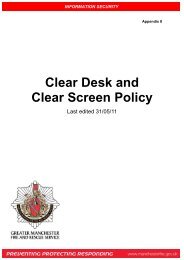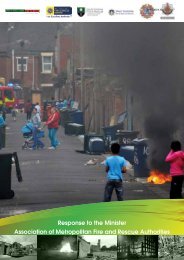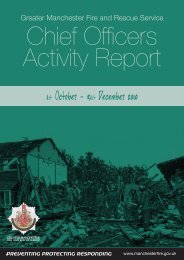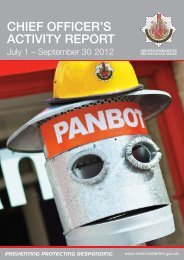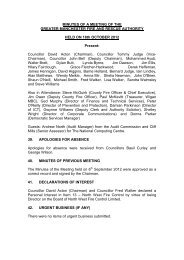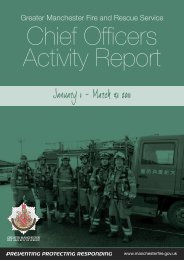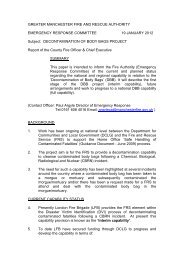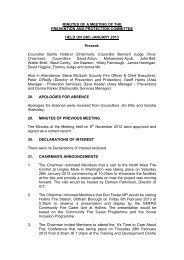Appendix A , item 39. PDF 1 MB - Greater Manchester Fire and ...
Appendix A , item 39. PDF 1 MB - Greater Manchester Fire and ...
Appendix A , item 39. PDF 1 MB - Greater Manchester Fire and ...
Create successful ePaper yourself
Turn your PDF publications into a flip-book with our unique Google optimized e-Paper software.
APPENDIX A<br />
Operational<br />
Assurance<br />
Plan<br />
2013-2014
Contents<br />
Section 1 Introduction 5<br />
Background<br />
The Operational Assurance Assessment (OAA) Suite 6<br />
Section 2 Assurance Activities for 2013/14<br />
Allocation of OA Assurance Days 8<br />
Flexible Approach<br />
Assuring Operational Activities 9<br />
Role of the OA Officer<br />
Role of the Borough Officer<br />
Assuring Core Activities 11<br />
Borough Targets<br />
OA Monitoring <strong>and</strong> ‘Dip Sampling’ 13<br />
Assuring Corporate Exercises<br />
13<br />
Assessor Role 14<br />
Developing Peer Review 14<br />
Service Delivery Goals<br />
Thematic Reviews 15<br />
Debriefing Operational Activities 15<br />
Level One (Hot)<br />
Level Two (Tactical)<br />
Level Three (Strategic)<br />
2
Miscellaneous Assurance Activities 18<br />
Online Incident Presentations<br />
Fatal (<strong>and</strong> Possible Fatal) Incident Reports<br />
Senior Accident Investigations<br />
Dem<strong>and</strong> Led Activities 19<br />
Section 3 Identification <strong>and</strong> Management of Risk<br />
Operational Assurance Risk Management Process 20<br />
Safety Critical Events 21<br />
Recording Mechanisms 21<br />
Emerging Themes Register<br />
Directorate Risk Register<br />
Corporate Risk Register<br />
Risk <strong>and</strong> Intelligence Manager<br />
Operational Risk Control Group (ORCG)<br />
<strong>Fire</strong> Authority Audit, Scrutiny <strong>and</strong> St<strong>and</strong>ards Committee<br />
Annual Governance Statement (AGS)<br />
Review <strong>and</strong> Evaluation of the Assurance Plan 23<br />
Equality <strong>and</strong> Diversity Impact Assessment 23<br />
3
Appendices<br />
<strong>Appendix</strong> A<br />
<strong>Appendix</strong> B<br />
<strong>Appendix</strong> C<br />
<strong>Appendix</strong> D<br />
Annual Availability<br />
Emerging Themes Database<br />
Emerging Themes Process<br />
Prioritisation <strong>and</strong> Management of Risk<br />
4
1. Introduction<br />
1.1 Background<br />
<strong>Greater</strong> <strong>Manchester</strong> <strong>Fire</strong> <strong>and</strong> Rescue Authority has a legal responsibility to ensure<br />
that an effective <strong>Fire</strong> <strong>and</strong> Rescue Service (FRS) is provided across the city region.<br />
To help ensure this legal requirement is met, <strong>Greater</strong> <strong>Manchester</strong> <strong>Fire</strong> <strong>and</strong> Rescue<br />
Service (GMFRS) undertake active <strong>and</strong> reactive monitoring across a range of<br />
operationally focused activities undertaken by Borough based Officers <strong>and</strong> members<br />
of a dedicated Operational Assurance Team (OA).<br />
This Operational Assurance Plan for 2013/14 (the Ops Assurance Plan) sets out the<br />
Operational Assurance activities to be undertaken during 2013/14. It does so by<br />
adopting a ‘risk based’ approach to undertaking monitoring <strong>and</strong> assessment activities<br />
<strong>and</strong> progressing the resultant outcomes. This approach ensures resources are<br />
targeted in an efficient <strong>and</strong> effective manner in order to ensure:<br />
a) The Service has a safe, well trained <strong>and</strong> competent workforce capable of<br />
meeting the dem<strong>and</strong>s placed upon them<br />
b) The Emergency Response element of the Service is effectively working<br />
to achieve the purpose <strong>and</strong> aims of the Corporate Plan<br />
The Ops Assurance Plan contributes towards achieving the following Delivery Goals<br />
(DL):<br />
DL4 Reduce property damage, economic loss <strong>and</strong> damage to the environment.<br />
DL6 Ensure the public are highly satisfied with our services.<br />
DL8 Maintain a high state of preparedness for emergencies, effective emergency<br />
cover <strong>and</strong> a high quality response.<br />
DL14 Develop <strong>and</strong> sustain a high quality, performing, effective, well informed <strong>and</strong> well<br />
trained workforce.<br />
DL16 Develop <strong>and</strong> maintain confident, capable leaders <strong>and</strong> managers, with low levels<br />
of absenteeism, staff turnover <strong>and</strong> ill-discipline.<br />
DL17 Reduce our carbon footprint, use of natural resources <strong>and</strong> deliver our services<br />
in a sustainable way.<br />
DL18 Develop <strong>and</strong> maintain a safe workforce with low rates of accidents <strong>and</strong> injuries<br />
to our people.<br />
5
1.2 Operational Assurance Assessment Suite<br />
Development of the Operational Assurance Assessment (OAA) Suite<br />
The Service has been undertaking formal monitoring <strong>and</strong> assessment of its<br />
operational based activities since May 2005. In support of this work a comprehensive<br />
suite of reports 1 has been developed <strong>and</strong> continually refined. The current suite<br />
consists of:<br />
i. OAA - Incident Monitoring Report<br />
Provides assurance that operational activities are being undertaken in<br />
accordance with st<strong>and</strong>ard operating procedures, policies <strong>and</strong> guidance.<br />
ii.<br />
iii.<br />
iv.<br />
OAA - Training Report<br />
Provides assurance that Watch based operational personnel are<br />
undertaking training in accordance with st<strong>and</strong>ard operating procedures,<br />
policies <strong>and</strong> guidance.<br />
OAA - Exercise Report<br />
Provides assurance that activities undertaken during large scale<br />
exercises are in accordance with st<strong>and</strong>ard operating procedures,<br />
policies <strong>and</strong> guidance.<br />
OAA - Station Report<br />
Provides a comprehensive assessment of the st<strong>and</strong>ard to which a<br />
range of ‘day to day’ station based activities are being undertaken.<br />
Areas covered during a station assessment include:<br />
Operational Preparedness<br />
Training <strong>and</strong> Development<br />
Planning <strong>and</strong> Preparation<br />
Prevention Activities<br />
Station Work Routines<br />
Documentation / Administration<br />
Health <strong>and</strong> Safety<br />
v. OAA - Work Routine Report<br />
Provides assurances that station based personnel are working in<br />
accordance with the 'Policy Guidance on the Planning <strong>and</strong><br />
Management of Work Routines'.<br />
vi.<br />
OAA - Thematic Review<br />
Thematic reviews are agreed with the Operational Risk Control Group<br />
(ORCG), based upon areas of organisational risk <strong>and</strong>/or opportunity.<br />
Completed thematic reviews are reported to the Leadership Team (LT).<br />
1 This suite of documents is currently under review in order to provide refreshed key lines of enquiry<br />
within each report<br />
6
vii.<br />
OAA - Peer Review<br />
The Service is currently developing a Station based Peer Review<br />
process to focus upon the outcomes from Service Delivery activities.<br />
Specifically, this will review the performance of <strong>Fire</strong> Stations (<strong>and</strong><br />
subsequently the Boroughs) in meeting the purpose <strong>and</strong> aims of the<br />
Corporate Plan.<br />
7
2. Assurance Activities for 2013/14<br />
l<br />
2.1 Allocation of OA Assurance Days<br />
The Operational Assurance Team (OA) consists of four Station Managers <strong>and</strong> one<br />
Group Manager, led by the Head of Operational Assurance <strong>and</strong> Performance. The<br />
core role of an OA Station Manager is to monitor <strong>and</strong> assess the operational<br />
activities undertaken by Borough/Station based personnel. Examination of the OA<br />
Station Manager rota identifies that each Officer is capable of providing a maximum<br />
of 152 days, per annum, for this purpose. (<strong>Appendix</strong> A).<br />
This equates to 608 ‘days of assurance’ against which, the team will deliver during<br />
2013/14, as detailed within Table 1 below:<br />
Table 1.<br />
OPERATIONAL ASSURANCE TEAM<br />
ASSURANCE ACTIVITIES<br />
ASSURANCE DAYS<br />
Total Assurance Days Available 608<br />
1. OAA - Incidents Activities 120 2<br />
2. OAA – Core Activities<br />
( Station, Training <strong>and</strong> Work Routine OAAs)<br />
3. OAA - Exercise Activities 30<br />
4. Assessor Role 50<br />
5. Peer Review Development 60<br />
6. Thematic Reviews (x 4) 120<br />
7. Operational Debriefing Activities 45<br />
30<br />
8. Miscellaneous Activities<br />
Online incident presentations<br />
Development of existing assurance IT systems<br />
Fatal / Possible Fatal incident reporting<br />
Joint Health & Safety/Accident Investigations<br />
Dealing with underperformance<br />
80<br />
9. Representation at meetings (including preparation) 40<br />
Total Assurance Days Allocated 575<br />
Contingency for dem<strong>and</strong>/risk led activities 33<br />
2 Commensurate with the full team available to attend operational incidents.<br />
8
2.2 Flexible Approach<br />
As can be observed within the Ops Assurance Plan, the annual availability of the OA<br />
is fully accounted for <strong>and</strong> allocated in accordance with a risk based approach to<br />
setting priorities. This workload is subsequently reflected within the OA Action Plan,<br />
which sets out ‘when <strong>and</strong> how’ the planned activities are to be undertaken during the<br />
forthcoming year, including clear targets <strong>and</strong> milestones against which delivery can<br />
be measured.<br />
Whilst a notional allocation of 33 assurance days has been afforded as a<br />
contingency for ‘dem<strong>and</strong> led work’, experience has shown that the identification of<br />
significant organisational risk (or opportunity) can occur at any time. Therefore, to be<br />
realistic, the Ops Assurance Plan must retain a high degree of flexibility, thereby<br />
ensuring OA can remain sufficiently agile to respond to any new developments.<br />
Any variance from the activities contained within the Ops Assurance Plan should be<br />
risk based <strong>and</strong> must only be implemented in full agreement with the Director of<br />
Emergency Response (DER). Any variance will be captured <strong>and</strong> subsequently<br />
reported as an element of the Emergency Response Directorate reporting process<br />
<strong>and</strong> also within the Ops Assurance Plan outcome reports produced for the <strong>Fire</strong><br />
Authority Audit, Scrutiny <strong>and</strong> St<strong>and</strong>ards Committee.<br />
2.3 Assuring Operational Activities<br />
Role of the OA Officer<br />
A fundamental role of the OA is to support the achievement of the Service Delivery<br />
goals. In pursuance of this requirement, OA members undertake the monitoring <strong>and</strong><br />
assessment of activities across a wide range of operational incidents including:<br />
Any ‘make up’ incident*<br />
Water incidents<br />
Special Service Incidents that necessitate the mobilisation of either a Station<br />
Manager or Hazardous Materials & Environmental Protection Officer (HMEPO)<br />
All incidents where persons are reported to be involved<br />
Road Traffic Collision incidents involving multiple vehicles or confirmed persons<br />
trapped<br />
Confirmed acetylene incidents<br />
All fatal (<strong>and</strong> possible fatal) fires<br />
Other ‘significant’ incidents<br />
9
Additional benefits achieved through undertaking an ‘Incident OAA’ are that the<br />
reviewing Officer is also afforded the opportunity to:<br />
i. Mentor <strong>and</strong> support less experienced colleagues at the incident<br />
ii.<br />
Gather <strong>and</strong> provide evidence in support of the Maintenance of Competency<br />
Records (MCR) process<br />
iii.<br />
Review the activities of relief crews to ensure incidents are being adequately<br />
progressed towards a conclusion<br />
iv. Ensure compliance with the Organisational Debriefing Policy (see 12.)<br />
v. Capture images for use in the production of ‘Online Incident Presentations’<br />
Based upon the 2012/13 levels of activity, each OA Station Manager has been<br />
allocated 30 days for assuring operational incidents. (120 days total, assuming a full<br />
establishment of qualified OA members).<br />
*A ‘Make Up’ is a request for <strong>Fire</strong> Service resources, additional to those initially mobilised to resolve<br />
an incident.<br />
10
2.4 Role of the Borough Officer<br />
When a Flexible Duty System (FDS) Officer is mobilised in the ‘Incident Comm<strong>and</strong>er’<br />
role, they must conduct an initial assessment of the incident to determine if they will<br />
assume comm<strong>and</strong> (take charge), or elect to undertake an observational/ advisory<br />
role.<br />
There is an expectation that any FDS Officer not electing to ‘take charge’ will<br />
undertake an incident OAA, whenever practicable. This requirement does not apply<br />
to any incident to which an OA Officer has been mobilised.<br />
2.5 Assuring Core Activities<br />
The term ‘core activities’ applies to a range of basic OAA reports (Station, Training<br />
<strong>and</strong> Work Routine) that are primarily focused upon preparedness activities <strong>and</strong><br />
st<strong>and</strong>ards on fire stations.<br />
11
2.6 Borough Targets<br />
Responsibility for completion of core assurance activities has been devolved to<br />
Borough level with a requirement that all Station Managers will complete an average<br />
of one core OAA per month, set as an annual target.<br />
Each Borough has been assigned a core OAA requirement, (see Table 2: Borough<br />
Targets). This requirement is proportional to the number of Station Managers <strong>and</strong> the<br />
crewing arrangements (e.g. wholetime, or non-wholetime), at the stations for which<br />
they hold responsibility.<br />
Borough Managers should adhere to Table 2 in order to ensure the required targets<br />
are achieved <strong>and</strong> should aspire to remain within this target for each quarter. In those<br />
cases where a target has not been achieved due to unforeseen circumstances, the<br />
deficit is to be made up at the earliest opportunity <strong>and</strong> by no later than the end of the<br />
following quarter.<br />
The reporting process for completion of core OAA reports should form an integral<br />
part of the respective Area Manager performance meetings.<br />
Table 2: Borough Targets<br />
Core Assurance Activities<br />
BOROUGH<br />
Number<br />
of Station<br />
Managers<br />
Number<br />
of<br />
Stations<br />
Number of<br />
OAA Station<br />
Reports<br />
Per annum<br />
Number of<br />
OAA Work<br />
Routine<br />
Reports<br />
Per annum<br />
Number of<br />
OAA Watch<br />
Training<br />
Reports<br />
Per annum<br />
Total OAA<br />
Reports<br />
per<br />
Month<br />
&<br />
Quarter*<br />
ANNUAL<br />
TOTAL<br />
BOLTON 3 4 7 12 17 3 (9) 36<br />
BURY 2 3 5 8 11 2 (6) 24<br />
MANCHESTER 7 7 14 28 42 7 (21) 84<br />
OLDHAM 3 3 6 12 18 3 (9) 36<br />
ROCHDALE 2 3 7 8 9 2 (6) 24<br />
SALFORD 4 5 9 16 23 3 (9) 48<br />
STOCKPORT 3 5 9 16 11 3 (9) 36<br />
TAMESIDE 3 4 7 12 17 3 (9) 36<br />
TRAFFORD 3 3 6 12 18 3 (9) 36<br />
WIGAN 3 4 8 16 12 3 (9) 36<br />
*Quarterly target shown in brackets ( )<br />
12
2.7 Methodology Applied<br />
The minimum Borough requirements are based upon delivery of one ‘core OAA’ per<br />
Station Manager, per month (e.g. 3 x SM = 36 OAA per year) <strong>and</strong> consist of:<br />
Two ‘Station OAA’ at each wholetime fire station, per annum<br />
One ‘Station OAA’ at each non-wholetime fire station, per annum<br />
One Work Routine OAA per watch, per year at all wholetime stations<br />
(N/A for non wholetime)<br />
The balance of OAA requirements make up the watch training reports<br />
2.8 OA Monitoring <strong>and</strong> ‘Dip Sampling’<br />
The volume of core assurance activities being undertaken across the Service makes<br />
it impractical for OA to ensure that all assessments are being conducted to the<br />
required st<strong>and</strong>ard. Therefore OA will undertake a five per cent ‘dip sample’ across<br />
the full range of completed OAA reports to monitor compliance <strong>and</strong> provide quality<br />
assurance. In addition to ‘dip sampling’ OA will undertake targeted OAAs in response<br />
to concerns identified through the conventional environmental scanning processes.<br />
To allow for completion of the required number of core OAA reports, administration<br />
<strong>and</strong> oversight of the process <strong>and</strong> progression of related issues, OA have allocated a<br />
total of 30 assurance days to delivering this aspect of the Ops Assurance Plan.<br />
2.9 Assuring Corporate Exercises<br />
The Operational Assurance Team will attend all GMFRS Service Wide <strong>and</strong> Large<br />
Scale exercises for the purpose of undertaking the Exercise OAA. Where resources<br />
allow, this activity will be extended to joint exercises taking place within neighbouring<br />
<strong>Fire</strong> <strong>and</strong> Rescue Services.<br />
These activities provide the Service with assurance that:<br />
a) The required range of training exercises is being undertaken in accordance with<br />
the Corporate Exercises Policy <strong>and</strong> Guidance Document.<br />
b) Personnel are working in accordance with st<strong>and</strong>ard operating procedures,<br />
policies <strong>and</strong> guidance within the training environment.<br />
c) Learning opportunities are being maximised through support of collaborative<br />
working <strong>and</strong> Peer Review activities etc.<br />
To allow for completion of the required number of Exercise OAA reports <strong>and</strong><br />
progression of related issues, OA have allocated a total of 30 assurance days to<br />
delivering this aspect of the Ops Assurance Plan.<br />
13
2.10 Assessor Role<br />
All OA Officers are accredited auditors <strong>and</strong> provide an assessor capacity throughout<br />
the year to support delivery of the Training <strong>and</strong> Development Schedule.<br />
Typically such activities involve OA Officers assessing Incident Comm<strong>and</strong> abilities<br />
during dedicated training events (e.g. high rise training), assisting with the<br />
assessment of Officer incident comm<strong>and</strong> skills within the Training <strong>and</strong> Development<br />
Centre simulation suite <strong>and</strong> during the Watch <strong>and</strong> Crew Manager development<br />
courses.<br />
In agreement with Operational Training Management, OA have allocated 50<br />
assurance days to delivering this aspect of the Ops Assurance Plan during 2013/14.<br />
This assessor capacity is reported within the Bi-Annual outcome report to the Audit,<br />
Scrutiny <strong>and</strong> St<strong>and</strong>ards Committee.<br />
2.11 Developing Peer Review<br />
To further improve the established ways of reviewing the performance of fire stations<br />
in delivering the Corporate Plan, the Service is currently developing a Station Peer<br />
Review process.<br />
Once implemented, this process is intended to provide an internal means to monitor<br />
how effectively our stations are achieving the ‘Service Delivery Goals’ <strong>and</strong> will<br />
identify areas of weakness <strong>and</strong> highlight areas of good practice <strong>and</strong>/or excellence.<br />
2.12 Service Delivery Goals<br />
Service Delivery Goals underpin <strong>and</strong> support the strategic purpose <strong>and</strong> aims of the<br />
organisation. Therefore the most logical <strong>and</strong> simplistic way of monitoring how<br />
effectively stations are delivering against the Corporate Plan, is to consider<br />
performance against these goals.<br />
The ‘<strong>Fire</strong> Station Peer Review Process’ is intended to:<br />
Form a structured <strong>and</strong> consistent basis to drive continuous improvement<br />
within the Service.<br />
Assure stakeholders that the GMFRS is discharging its services safely <strong>and</strong><br />
successfully.<br />
Assist GMFRS to identify their strengths, areas for improvement, <strong>and</strong><br />
inform strategic improvement plans.<br />
Be used as a tool to assist GMFRS in the identification <strong>and</strong> dissemination<br />
of notable practice.<br />
Be flexible in design, <strong>and</strong> simple in delivery.<br />
It is anticipated that development of the Station Peer Review Process will form a<br />
significant piece of work for OA <strong>and</strong> therefore a total of 60 assurance days have<br />
been allocated to delivering this aspect of the Ops Assurance Plan during 2013/14.<br />
14
2.13 Thematic Reviews<br />
Thematic reviews are based upon specific areas of operational risk <strong>and</strong>/or<br />
opportunity identified within the Emergency Response arena, through utilisation of<br />
the Environmental Scanning Process to review all available sources<br />
A thematic review will typically involve detailed research <strong>and</strong> analysis of a subject<br />
matter, in order to provide the Leadership Team with an informed report for due<br />
consideration <strong>and</strong> subsequent action, as appropriate.<br />
The identification of significant organisational risks (or opportunities) can occur at any<br />
time <strong>and</strong> therefore a flexible approach is applied to undertaking thematic reviews,<br />
thereby ensuring OA can remain sufficiently agile to respond to new developments.<br />
OA will aim to undertake a minimum of one prioritised thematic review, per quarter.<br />
The topic for each thematic review will be determined by the Operational Risk<br />
Control Group (ORCG).<br />
To allow for completion of four thematic reviews during 2013/14, OA have allocated a<br />
total of 120 assurance days to delivering this aspect of the Ops Assurance Plan<br />
2.14 Debriefing Operational Activities<br />
Reviewing workplace activity is an effective means of improving performance <strong>and</strong><br />
therefore it is the aim of GMFRS to review operational activities on a regular basis.<br />
The application of a robust debrief process provides the organisation with an<br />
opportunity to learn from both successes <strong>and</strong> improvement opportunities identified<br />
during operational related activities.<br />
This activity is managed by the OA Team <strong>and</strong> achieved through ensuring debriefs<br />
are undertaken following all operational incidents <strong>and</strong> training activities at which<br />
improvement opportunities, or successes have been recognised. The OA Team is<br />
also responsible for collating <strong>and</strong> utilising the feedback gathered through this<br />
process.<br />
15
There are three main types of Operational Debrief undertaken within GMFRS:<br />
i. Level One (Hot) Debrief<br />
Carried out at the earliest opportunity following conclusion of an<br />
operational activity. Conducted either at the scene, or immediately upon<br />
return to the normal place of work.<br />
ii. Level Two (Tactical) Debrief<br />
Undertaken for any operational incident or training event which has the<br />
potential to raise significant learning opportunities.<br />
iii. Level Three (Strategic) Debriefs<br />
Strategic Debriefs provide a supportive <strong>and</strong> confidential environment in<br />
which the performance of the senior incident comm<strong>and</strong>er can be discussed<br />
openly. All Strategic Debriefs are coordinated <strong>and</strong> facilitated by OA <strong>and</strong><br />
focus specifically on ‘comm<strong>and</strong> decision making’.<br />
GMFRS first formalised arrangements for debriefing operational activities in 2005.<br />
The organisational approach has proven to be effective for a number of years in<br />
providing a robust <strong>and</strong> credible method for the capture <strong>and</strong> collation of<br />
incident/exercise outcomes.<br />
In recognition of the elapsed time since the introduction of the existing practices <strong>and</strong><br />
in response to an accumulation of related issues on the OA Emerging Themes<br />
Register, a review of the existing was undertaken during Quarter four of 2012/13.<br />
The review found that the current level of ‘buy in’ from operational staff is viewed as<br />
a significant area for improvement, as is the ‘closing the loop’ element of the current<br />
procedures which presents some risk to the organisation through lack of awareness.<br />
This also has the potential to stifle both organisational learning <strong>and</strong> service<br />
improvement.<br />
As an outcome from the review, the following recommendations for improvement<br />
were agreed by LT at its meeting of 8 March 2013:<br />
(i)<br />
(ii)<br />
Provide a more pragmatic approach to the completion <strong>and</strong> monitoring<br />
of tactical debriefs, through the removal of the targeted (Quantitative)<br />
approach <strong>and</strong> replace this with a more reasonable (Qualitative)<br />
approach which focuses on developing a culture of learning.<br />
Existing OA procedures should be strengthened to include active<br />
monitoring <strong>and</strong> analysis of both resolved <strong>and</strong> unresolved issues, for the<br />
purpose of informing the Emerging Themes Register.<br />
To maximise the benefit of this resource intensive activity, the current<br />
strategic debrief process should be refined to ensure the learning<br />
outcomes are more effectively shared with a wider audience. This<br />
should include more effective communication of the collective<br />
outcomes by OA, in the form of a quarterly presentation to all<br />
operational personnel.<br />
16
(iii)<br />
Development or replacement of the current electronic debriefing system<br />
itself.<br />
Progression of the review recommendations will ensure that GMFRS maintains a<br />
debriefing system which remains ‘fit for purpose’ <strong>and</strong> justifies the considerable<br />
resources being invested, through delivering meaningful outcomes <strong>and</strong> driving<br />
service improvement.<br />
Delivering these outcomes will form a significant activity for the OA <strong>and</strong> therefore 60<br />
assurance days have been allocated to delivering this aspect of the Ops Assurance<br />
Plan during 2013/14.<br />
17
2.15 Miscellaneous Assurance Activities<br />
As an integral aspect of the working day OA Officers undertake a range of<br />
miscellaneous activities. Examples of some of the more involved activities are<br />
provided below.<br />
Online Incident Presentations<br />
In performance of the role, OA Officers are ideally placed to capture images of<br />
activities taking place at operational incidents <strong>and</strong> during training exercises.<br />
Since the autumn of 2010 OA Officers have been compiling the captured images into<br />
PowerPoint presentations which are shared with the Training <strong>and</strong> Development<br />
Centre (TDC) <strong>and</strong> published on the BigRed, in order to provide feedback to<br />
operational crews.<br />
This process helps to ensure that experiences from incidents <strong>and</strong> training scenarios<br />
are used to advise future practice, identify safety matters <strong>and</strong> to provide an<br />
invaluable debriefing tool.<br />
The incident presentations are now fully established <strong>and</strong> are proving to be very<br />
popular with all personnel within GMFRS, achieving on average around 3,000 ‘hits’<br />
per quarter, with 4,500 hits achieved during ‘Quarter 4’ of 2013/14.<br />
During 2013/14 the OA Team will further develop this resource to include video<br />
footage <strong>and</strong> to make a routine submission to TDC <strong>and</strong> the Incident Comm<strong>and</strong><br />
Academy, to assist with developing incident comm<strong>and</strong> competences.<br />
Fatal (<strong>and</strong> Possible Fatal) Incident Reports<br />
OA capture <strong>and</strong> report upon fire service actions taken prior to, during, <strong>and</strong> following<br />
any incident where a confirmed (or possible) fatality has occurred. This procedure<br />
was developed to supplement, rather than duplicate, the established fire investigation<br />
reports <strong>and</strong> the Ops 17 Fatal Incident Details report.<br />
The OA procedure seeks to determine:<br />
i. Any previous GMFRS involvement – for example, any inclusion on a<br />
vulnerable person register, details of prior Home Safety Checks, etc.<br />
ii. The actions taken by operational personnel - incident response times,<br />
adherence to relevant policy, initial actions, etc.<br />
iii. Post incident activities – Home Safety Support campaigns, BeatSweeps<br />
arranged, etc.<br />
18
The OA procedure is currently under review by the Prevention <strong>and</strong> Protection<br />
Directorate as an aspect of the Significant Incident Policy.<br />
Senior Accident Investigation<br />
OA team members are required to attain the National Examining Board for<br />
Occupational Safety <strong>and</strong> Health (NEBOSH) qualification at certificate level <strong>and</strong> to<br />
undertake the Senior Accident Investigator role.*<br />
This ensures team members are adequately equipped to fully investigate all Safety<br />
Critical events encountered <strong>and</strong> to furnish the Health <strong>and</strong> Safety department with the<br />
requisite reports.<br />
Dem<strong>and</strong> Led Activities<br />
There are many occasions where the OA (at the direction of the DER) undertake<br />
short notice, dem<strong>and</strong> led activities arising from identified organisational risk.<br />
Examples of such activities undertaken during 2012/13 include undertaking joint<br />
Health & Safety/Accident Investigations, conducting Turnout Trials, improving Ops<br />
Alert procedures <strong>and</strong> leading on rationalising ‘Change of Watch Protocols’.<br />
* The role of Senior Accident Investigator is currently under review.<br />
19
3. Identification <strong>and</strong> Management of Risk<br />
3.1 Operational Assurance Risk Management Process<br />
The identification, capture <strong>and</strong> progression of risks to the operational function of the<br />
service is pivotal to the role of the OA <strong>and</strong> supporting processes to provide this have<br />
been developed over a number of years. Generally, the operational risks <strong>and</strong><br />
opportunities identified in line with OA activities fall into one of two broad categories,<br />
namely ‘people issues’ or ‘process issues’.<br />
People issues are typically simple to address <strong>and</strong> are often resolved at Watch,<br />
Station, or Borough level.<br />
Process issues on the other h<strong>and</strong>, tend to be more complex in nature, often requiring<br />
for example, the revision of policy or procedure <strong>and</strong> thus cannot be resolved at local<br />
level. Therefore process issues are collated by OA <strong>and</strong> progressed through to the<br />
relevant department, directorate or forum for further action as appropriate.<br />
In 2012/13 OA revised its risk management process to ensure it accords with the<br />
Corporate Model.<br />
3.2 Safety Critical Events<br />
Occasionally during execution of the role, the OA Officer will observe an action or<br />
omission that is considered to have potential to cause serious injury or severe<br />
damage to equipment, or to the environment. Such occurrences are termed ‘Safety<br />
Critical’ events.<br />
All safety critical events must be challenged <strong>and</strong> where possible rectified<br />
immediately. The OA Officer will, at the earliest opportunity, issue a ‘Safety Critical<br />
Notice’ to the individual(s) concerned via their Borough Manager.<br />
3.3 Recording Mechanisms<br />
Emerging Themes Register<br />
The Emerging Themes Register has been an inherent part of the operational<br />
assurance process since 2005. The register is maintained by OA <strong>and</strong> acts as a<br />
‘catch all’ for issues identified during the range of activities undertaken by the team<br />
<strong>and</strong> through the environmental scanning process.<br />
The register is under continuous review to ensure it remains current.<br />
20
Directorate Risk Register<br />
This register is maintained by the Directorate Risk Champion (Area Manager) to<br />
collate the issues applicable to this level. The Directorate Risk Register is a st<strong>and</strong>ing<br />
<strong>item</strong> for discussion at the quarterly ER Planning meeting.<br />
Corporate Risk Register<br />
The Corporate Risk Register is maintained by the Risk & Intelligence Manager (RIM)<br />
<strong>and</strong> is owned by the Corporate Leadership Team (CLT). The register is utilised in a<br />
range of meeting forums <strong>and</strong> reviewed by Members of the <strong>Fire</strong> Authority at the<br />
quarterly meeting of the Audit, Scrutiny <strong>and</strong> St<strong>and</strong>ards Committee.<br />
Risk <strong>and</strong> Intelligence Manager (RIM)<br />
The RIM is pivotal to the risk management process <strong>and</strong> has the responsibility for<br />
reporting directly to CLT <strong>and</strong> the <strong>Fire</strong> Authority. The RIM has primary responsibility<br />
for maintaining the Corporate Risk Register including the allocation of risk identifiers<br />
in order to track <strong>and</strong> report upon the progression of a risk <strong>and</strong> associated mitigating<br />
actions.<br />
The OA undertake collation of all Operational Assurance Assessments <strong>and</strong> as a<br />
consequence, are responsible for providing regular update reports to all interested<br />
parties, generally driven by the individual meeting schedules.<br />
Interested parties include:<br />
Emergency Response Directorate (Quarterly Reporting Cycle)<br />
Health <strong>and</strong> Safety Department<br />
Directorate Risk Champion<br />
Operational Risk Control Group (ORCG)<br />
Operational Procedures <strong>and</strong> Equipment Forum (OPEF)<br />
Corporate Leadership Team (CLT)<br />
Consultation, Research <strong>and</strong> Assurance Group (CRAG)<br />
Leadership Team (LT)<br />
Audit <strong>and</strong> Risk Management, Wigan Council (Internal Audit)<br />
<strong>Fire</strong> Authority Audit, Scrutiny <strong>and</strong> St<strong>and</strong>ards Committee<br />
Delivery against the activities set out within this Ops Assurance Plan for 2013/14 will<br />
be reported to DER, in line with the scheduled quarterly meeting process <strong>and</strong> to the<br />
<strong>Fire</strong> Authority Audit, Scrutiny <strong>and</strong> St<strong>and</strong>ards Committee, as detailed on page 9 of this<br />
plan.<br />
Operational Risk Control Group (ORCG)<br />
The purpose of the ORCG is to act as a cross-organisational control group to help<br />
manage “risks” likely to affect operational activities. The ORCG work to effectively<br />
resolve identified risks from a number of sources, including any unresolved <strong>item</strong>s<br />
arising from operational assurance related activities.<br />
21
The Emerging Themes Register sits as a st<strong>and</strong>ing <strong>item</strong> on the ORCG agenda at its<br />
bi-monthly meetings, where representatives from the key support departments work<br />
to resolve or progress the key issues.<br />
Those risks which the ORCG are unable to resolve, or where the issues are<br />
considered to be beyond the authority of the ORCG, are placed on the appropriate<br />
Corporate or Directorate risk register <strong>and</strong> communicated to the ‘Consultation,<br />
Research <strong>and</strong> Assurance Group’ (CRAG) <strong>and</strong> Leadership Team.<br />
ORCG maintain an action summary detailing progress against all identified risks.<br />
This is communicated to the CRAG <strong>and</strong> Leadership Team for consideration at the<br />
next available meeting <strong>and</strong> also forms part of the OA reporting process to the <strong>Fire</strong><br />
Authority Audit, Scrutiny <strong>and</strong> St<strong>and</strong>ards Committee.<br />
<strong>Fire</strong> Authority Audit, Scrutiny <strong>and</strong> St<strong>and</strong>ards Committee<br />
To ensure consistency of approach, OA reporting activities directly align with <strong>and</strong><br />
complement those utilised by the Internal Audit Service. In pursuance of this<br />
requirement, delivery against the activities set out within this Ops Assurance Plan for<br />
2013/14 will be reported to the <strong>Fire</strong> Authority Audit, Scrutiny <strong>and</strong> St<strong>and</strong>ards<br />
Committee in accordance with the programmed ‘timetable of meetings’.<br />
Annual Governance Statement<br />
OA will provide information to support assurance at this level <strong>and</strong> will report within<br />
the Annual Governance Statement (AGS).<br />
3.4 Review <strong>and</strong> Evaluation of the Ops Assurance Plan<br />
The activities set out within the Ops Assurance Plan will be subject to continual<br />
review so as to ensure they continue to meet with corporate expectation <strong>and</strong> satisfy<br />
the objectives defined within the introduction to this plan.<br />
3.5 Equality <strong>and</strong> Diversity Impact Assessment<br />
An initial equality <strong>and</strong> diversity impact assessment has been undertaken <strong>and</strong> no<br />
significant findings were identified.<br />
22
<strong>Appendix</strong> A<br />
Annual Availability<br />
Operational Assurance Team Officer<br />
Annual Availability (Theoretical Number of OA Days Available) 248<br />
Annual leave (including public holidays) -37<br />
Work in support of Corporate Goals* -25<br />
Personal Development<br />
Core skill requirements<br />
‘One to Ones’ / PPR’s<br />
-15<br />
-4<br />
Other FDS References<br />
(Incident Liaison, Senior Accident Investigation, Hazardous Materials<br />
Officer, etc.)<br />
-15<br />
Total days allocated to other activities -96<br />
Total Days Available (Per Officer) 152<br />
*Relates to activities undertaken in support of delivering Corporate Goals that are not a direct responsibility of OA,<br />
but to which the function makes a meaningful <strong>and</strong> necessary contribution.<br />
23
<strong>Appendix</strong> B<br />
Figure 3: Screenshot from Emerging Themes Register<br />
25
Emerging Themes Process Map<br />
<strong>Appendix</strong> C<br />
Emerging Themes<br />
Register<br />
ETR is<br />
udated<br />
A score is<br />
assigned against<br />
likelihood <strong>and</strong><br />
Impact<br />
The ETR<br />
multiplies<br />
likelihood <strong>and</strong><br />
impact to achieve<br />
a risk score<br />
The subject<br />
matter is identified<br />
on four<br />
occasions?<br />
Yes<br />
No<br />
The issue is<br />
retained on<br />
the ETR. OA<br />
continue<br />
monitoring<br />
Contents of<br />
ETR<br />
communicated<br />
via usual<br />
channels<br />
Departmental risk<br />
Register<br />
Issue entered<br />
onto<br />
Departmental<br />
Risk Register<br />
OA Team<br />
Link from<br />
corporate<br />
Risk<br />
management<br />
Process<br />
Identifying officer<br />
enters the issue<br />
onto the ETR<br />
The four risk<br />
scores are<br />
combined to give<br />
an overall score<br />
<strong>and</strong> compared<br />
against the Risk<br />
Scale<br />
The risk<br />
scale<br />
determines<br />
if the risk is<br />
Low,<br />
medium or<br />
High<br />
Operational Risk<br />
Control group<br />
The issue is<br />
discussed at next<br />
ORCG
<strong>Appendix</strong> D<br />
Prioritisation <strong>and</strong> Management of Risk<br />
The OA methodology closely accords with the Corporate Risk Management Process.<br />
The Operational Assurance Team currently record all issues identified during<br />
operational incident monitoring (those which attract a score of three or below) in an<br />
Emerging Themes Register. The register collates these issues <strong>and</strong> displays them in<br />
an overall reporting sheet (see fig1).<br />
Fig 1: Emerging Themes Register; Reporting Sheet<br />
During 2012-13 individual issues recorded in the Emerging Themes Register were<br />
dealt with on an ad-hoc basis, for example, St<strong>and</strong>ard Messages were communicated<br />
to the responsible department through the Operational Risk Control Group; PPE was<br />
address by a Safety Critical Notice <strong>and</strong> a PNR; Incident Comm<strong>and</strong> issues have been<br />
addressed within the Incident Comm<strong>and</strong> Review, etc.<br />
27


